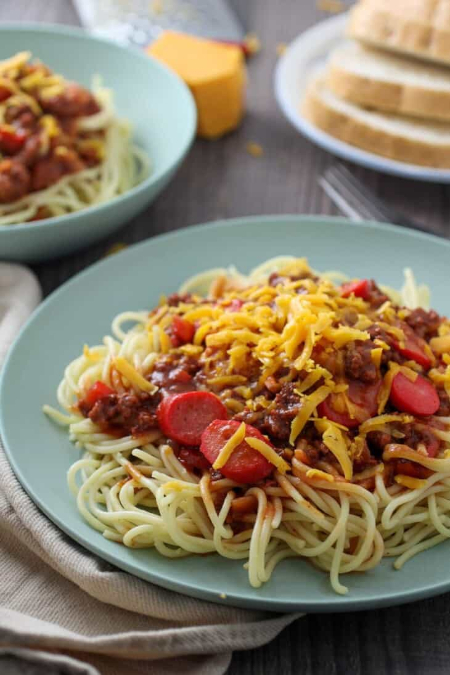The Philippines has been a crossroads of contrasting cultures for a thousand years. It’s felt the influence of many foreign cuisines in peace and war. And I just discovered a great Filipino dish!

I’ve just discovered Filipino Spaghetti (see photo, left) – an import from the U.S. that is now considered a staple.
How Spagh came to the islands
According to a history/review in Esquire Magazine, “Spaghetti was introduced to the country by the Americans in the late 19th century. It was among the dishes requested by the Americans who were looking for [foods] that remind them of home. There is no record or historical recipe of who invented the sweet spaghetti and where it originated in the country.”
Nuff said.
What it it, exactly?
The Filipino version uses the same Spaghetti noodles as the familiar Italian and North American versions. And it’s often described as an adaptation of Spaghetti Bolognese, an ancient Italian staple.
But the meat sauce – though familiar-looking – has evolved a flavour all of its own. In fact, it’s decidedly sweet. That’s the Banana Ketchup. (More on it, in a minute.)
If you can’t get Banana Ketchup, just use regular Tomato Ketchup and add a teaspoon or two of sugar to match the sweetness of the Banana type.
One distinctive difference between Filipino Spagh and the original Bolognese is that you add chunks of sizzled Hot Dog to the final mix. Aficionados say you can use Ham, SPAM, Smoky Bacon or Vienna Sausages for variety.
Mushrooms aren’t totally traditional, but broadminded fans say they make a great addition.
The ‘make-do’ origin of Banana Ketchup
They say many of the great inventions we take for granted today came about out of necessities and the various pressures of war. SO it was with Banana Ketchup.
During the Second World War, the U.S. commander in the Pacific, General Douglas MacArthur was faced with a serious food-related crisis. Filipino restaurants couldn’t get tomato-based products. They had to be imported because tomatoes won’t grow in the islands. Supplies from the U.S. were cut off as non-essential. But ketchup was the favourite condiment of American forces based in the Philippines.
Little known outside the islands, war heroine and food scientist Maria Orosa discovered a way to make a ketchup substitute out of bananas. Her concoction was not naturally red, so she had to use food colouring.
Legend has it that MacArthur one day ordered his favourite, Neapolitan Spaghetti. His staff made him, instead, a dish with a Banana Ketchup sauce, and chunked hot dogs as a substitute for meatballs.
An energetic evolution
From its fairly simple origins, Fillipino Spaghetti evolved over the following decades to what it is today. Future generations of chefs added ground meat to the sauce, aromatic vegetables (such as onions, celery and sweet peppers), and various spices. Today’s top recipes even call for some real tomato product. But the noodles and Hot Dogs have remained the same.
How popular is it?
Filipino foodie and chef Lalaine Manalo recalls: “Would you believe I ate the stuff five days a week for four years? Seriously. My high school cafeteria sold spaghetti to students and every day the packed lunch my mother made with tender loving care went untouched because I would instead spend my meager allowance on a plateful of the beet-red noodles.
“I don’t know what it is but there is just something so awful yet addictive about red hot dogs in banana catsup sauce.”
Manalo shares her recipe for authentic Filipino Spagh here.
Author, foodie Mario Alvaro Limos declares, “Today, Filipino spaghetti is considered comfort food, which is usually served at children’s birthday parties. What is a nightmare to Italian cuisine is a tale of creativity and resourcefulness to Filipino gastronomy. Filipino spaghetti is the craziest culinary quirk invented by Filipinos [yet]. It […] survived World War II and will be here to last.”
My take
Fortunately, we in urban North America can now get Banana Ketchup at almost any Asian grocery. And more and more of them are popping up every day.
This is a great dish for those who prefer sweet to spicy. It should also appeal to kids with picky palates.
I haven’t tried it, yet, but I have a very strong feeling I’ll like it. Although, maybe not 5 times a week!
~ Maggie J.

